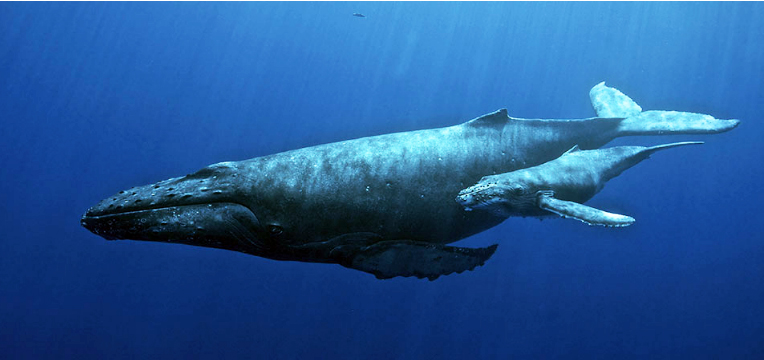Ocean noise refers to sounds made by human activities that can interfere or obscure the ability of marine animals to hear natural sounds in the ocean.
Many marine organisms rely on their ability to hear for their survival. Sound is the most efficient means of communication underwater and is the primary way that many marine species gather and understand information about their environment. Many aquatic animals use sound to find prey, locate mates and offspring, avoid predators, guide their navigation, locate habitat, and listen and communicate with each other. But over the last century, human activities such as shipping, recreational boating, and energy exploration have increased along coasts, offshore, and deep ocean environments.
What is the problem? Sound is a fundamental component of habitat that many ocean animals and ecosystems have evolved to rely on over millions of years. It is the most efficient means of communication over distance underwater. In the last 100 years, human activity has increased in more coasts, further offshore, and in deep ocean environments. Noise from this activity travels long distances underwater, leading to increases and changes in ocean noise levels.
Rising noise levels can negatively impact ocean animals and ecosystems in complex ways. Higher noise levels can reduce the ability of animals to communicate with potential mates, group members, offspring, or feeding partners. Noise can reduce an ocean animal’s ability to hear environmental cues vital for survival, including those key to avoiding predators, finding food, and navigation to preferred habitats.
NOAA’s approach to managing ocean noise aims to reduce negative physical and behavioral impacts to trust species, as well as conserve the quality of acoustic habitats. In 2010, NOAA committed to improving the tools used by the Agency to manage underwater noise impacts more comprehensively, including to better address cumulative impacts to whales, dolphins, and porpoises. This commitment led to two phases:
- Phase 1: The CetSound phase develops two mapping tools, CetMap and SoundMap, which aim to improve our ability to visualize cetacean density and distribution, and man-made underwater noise, respectively.
- Phase 2: The Ocean Noise Strategy, identified NOAA’s long-term ocean noise management goals, and the science and policy mechanisms for NOAA to meet those goals. This continues through the development and implementation of plans to achieve program Strategy goals across the agency.
How far does sound travel in the ocean? The distance that sound travels in the ocean varies greatly, depending upon water temperature and pressure. Water temperature and pressure determine how far sound travels in the ocean.
While sound moves at a much faster speed in the water than in air, the distance that sound waves travel is primarily dependant upon ocean temperature and pressure. While pressure continues to increase as ocean depth increases, the temperature of the ocean only decreases up to a certain point, after which it remains relatively stable. These factors have a curious effect on how sound waves travel, and how far.
Whales produce sound waves that move like ripples in the water. As the whale’s sound waves travel through the water, their speed decreases with increasing depth as temperature drops, making sound waves refract downward.
Once the sound waves reach the bottom of what is known as the thermocline layer, the speed of sound reaches its minimum. The thermocline is a region characterized by rapid change in temperature and pressure, which occurs at different depths around the world. Below the thermocline “layer,” the temperature remains constant, but pressure continues to increase. This causes the speed of sound to increase, making sound waves refract upward.
The area in the ocean where sound waves refract up and down is known as the “sound channel.” The channeling of sound waves allows sound to travel thousands of miles without the signal losing considerable energy. In fact, hydrophones, or underwater microphones, if placed at proper depth, can pick up whale songs and manmade noises far away.
Unfortunately, according to Alicia Gref, in her article “Ocean Noise is so loud, Humpback Whales Stop Singing,” although Humpback whales have become well-known for their beautiful songs, researchers have found that noise coming from ships is enough to make them shorten their songs, or stop singing altogether. Conservationists have addressed this issue at a summit held by the International Maritime Organization, where almost a dozen organizations called for slowing of ship speeds to reduce noise.
“Underwater noise from ships increases levels of stress-related hormones in whales, which can impact their ability to reproduce and impair their immune systems. Because whales and dolphins are highly dependent on sound to communicate, navigate, socialize, and locate prey, a noisy ocean is one in which their field of ‘vision’ shrinks, requiring whales to increase the amplitudes of their calls,” Regina Asmutis-Silvia, Executive Director of Whale and Dolphin Conservation said.
Not only would slowing of ships speed make the ocean quieter for marine mammals and reduce their stress levels, it would have the added benefits of reducing the risk of ship strikes, and reducing greenhouse gas emissions as well.
References
- What is Ocean Noise? NOAA.gov.
- Gref, Alicia. Ocean Noise is so loud, Humpback Whales Stop Singing. Care2. IMO EIN News. 26-October-2018.
